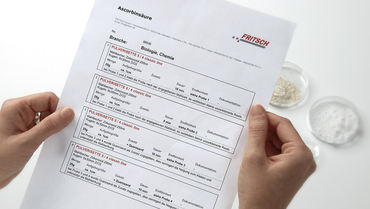Назад к обзору
Additives for dry milling
During a dry grinding, often only after a short grinding period hygroscopic material tends to stick. A second factor causing this is the static charge respectively adhesive powers of fine particles.
Also heterogenic materials– with elements of varying hardness – tend to stick, like for example plant samples or leaves where the thin leaves are ground fast to a fine powder but the harder / tougher stems remain coarse, but the fine leave material tends to stick together.
With an abrasive sintered corundum (Al2O3) grinding set, the hard stems can be comminuted faster. The disadvantage of an “abrasive” grinding set is an early adhering of the particles even though a homogenous sample is achieved with a relatively close grain size spectrum, but with values in a coarser grain size range.
For the utilization of sintered corundum this means:
- a) brief grinding time
- b) a homogenous sample (without stems)
- c) no high final fineness during dry grinding (approximately 50 - 70 μm)
For example, when working with a smooth, a specifically bit heavier Zirconium Oxide (ZrO2) grinding set, after a longer grinding period stickiness is unavoidable.
The advantage: the very smooth surface reduces the adhesive effect, i.e. it can be ground down into the range of approximately 30-40 μm.
The disadvantage: hard, tough-elastic parts are only deformed and found partially flattened in the sample.
The grinding result is not satisfactory!
A) A well-known possibility to correct this is the utilization of diverse „abrasive“ additives: The percentages of these additives has to be matched to the chemical affinity of the samples.
In most cases 2-5% of abrasive additives are sufficient, abrasive additives are for example:
| Material: | Feed size: | Addition in % |
| Quartz sand (SiO2) | 0.2 – 1 mm | 2 - 10 |
| Glass (SiO2) | 1 – 3 mm | 2 - 10 |
| Silicon carbide (SiC) | 300 – 500 μm | 2 - 5 |
| Boron carbide (B4C) | 300 – 500 μm | 2 - 5 |
| Corundum (Al2O3) | 300 – 50 0μm | 2 - 5 |
These abrasive materials keep slightly sticky sample material longer mobile and ensure therefore a corresponding larger final fineness due to higher “abrasive properties”. With a subsequent chemical analysis or extraction (the dissolving of active agents from a substance) the “abrasive assistants” remain in the filter and do not influence the analysis.
B) But there are three additional groups of elements with which during dry comminution an adherence can be reduced, respectively delayed.
1) Just simply add liquid and continue to comminute “dry”! And… the key is the amount! For example 0.1 - 0.5 g glycol (ethylene glycol) per 100 g of sample = 5 - 25 drops cause (with an already existing adhesion) a good flow characteristic; the sample remains dry, the charge / adhesion powers are reduced and the grinding period can be substantially increased. With gypsum for example a final fineness of below 20 μm can be obtained.
2) An additional application is the addition of „Aerosil“. It is a fine particle silicon dioxide with a very large surface. Here the additive is either added directly to the sample or when the adhesion begins in a concentration of 0.5 - 2%.
3) During tests with different wax types the best result corresponded with the longest possible grinding durations. Whereas especially the „magnesium-stearate“ (1 - 2%) and „stearic acid“ (it possesses hard-flaky platelets) with an application of 2 - 3% keep the samples mobile and capable of flowing for long periods of time.
An important question shall not be ignored at the end: Does the stearic acid interfere with additional analyses? Or is it better to grind wet in a suspension?
-
Download the FRITSCH-report as PDF file
-
Detailed grinding reports
Назад к обзору









